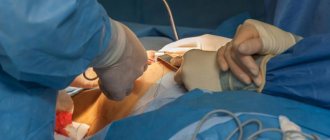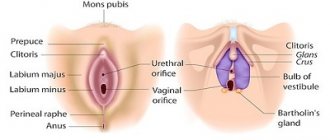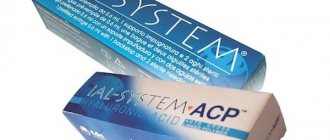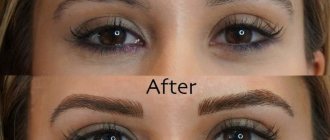Blepharoplasty (literally translated as eyelid surgery (from the Greek word “Blepharon” - eyelid). This surgical intervention, which involves the correction of age-related changes in the upper and lower eyelids, involves the delicate excision of excess skin, as well as the correction of fat and muscle tissue.
Natalya Romanyutina, surgeon at the Art Clinic says:
“It will not be a secret that our eyes, like the mirror of the soul, are able to reveal a little of our inner world. Human facial expressions, especially in the eye area, will forever remain a miracle and a mystery to me. It seems so incredible to me that the precision of muscle contractions, elusive micro-movements that convey the unique, unique range of personal feelings and emotions inherent in each person. But, unfortunately, due to such complex functional and anatomical and physiological characteristics, the periorbital region is the most sensitive and the first to undergo age-related changes.”
These changes include loss of volume due to redistribution of the subcutaneous fat layer, progressive thinning of bone tissue, and decreased elasticity and skin tone.
There are also a number of negative factors that aggravate the inevitable age-related changes:
- chronic diseases
- hormonal and metabolic changes,
- smoking, alcohol, toxic drugs,
- psychological stress, depression,
- lack of sleep,
- chronic fatigue,
- working and living conditions,
- ultraviolet radiation,
- unbalanced diet,
- Heredity, gender, improper care of the area around the eyes, as well as constant exposure to gravity
Who is recommended for blepharoplasty?
If you are concerned about one of the problems listed below, then blepharoplasty will be the right way to solve them:
- sagging skin of the upper eyelid
- swelling caused by the presence of fatty deposits on the eyelids;
- bags under the eyes, tired appearance (fatty hernias);
- drooping corners of the eyes (sad look);
- excess skin in the lower eyelid area;
- deep wrinkles around the eyes;
- damage to the skin of the eyelids due to trauma and birth defects.
Rehabilitation
The recovery period after lower eyelid surgery is quite short, it lasts no more than 3 weeks. If you follow all the recommendations of your doctor, the tissue will be restored painlessly and quickly.
In the first week it is important:
- do not disturb the seams, and if you touch your eyes, do so only with disinfected fingers;
- apply cold compresses;
- give up makeup;
- wear sunglasses.
It is better to postpone visits to the solarium, swimming pool, and gym for 2 months. Even carrying heavy bags from the grocery store is contraindicated.
At what age is it recommended to have blepharoplasty?
Many patients ask this question. But there is no exact age period when this operation is necessary. Each person has his own special facial anatomy, unique facial expressions, his own genetic history, in the power of which he is. Everyone’s life develops differently, which means living conditions, occupational hazards, eating habits, sleep and rest, bad habits, and ultimately our state of mind. All these factors make noticeable adjustments to the appearance.
Some people at 50 years old do not feel any need to change anything in their appearance, while others at 35, once opening their eyes, cannot recognize their usual image in the reflection. There is a feeling that their changing face no longer matches their inner sense of self, disharmony arises.
Therefore, the indication for blepharoplasty is not the numbers in the passport, but an internal feeling of discomfort and objective anatomical changes requiring correction.
Complications and side effects
Not a single surgical intervention is complete without the appearance of hematomas and swelling. But this is no reason to panic. This phenomenon is just a reaction of the delicate skin of the eyelids. Typically, bruising and swelling completely disappear within 2 weeks after blepharoplasty. However, it is possible that more unpleasant effects may occur. These include:
- inflammation of the sutures due to infection;
- long periods of disappearance of hematomas, which are a consequence of extensive damage to blood vessels;
- the appearance of keloid scars;
- inversion of the lower eyelid due to the removal of a large amount of tissue;
- the occurrence of compactions due to incorrectly applied seams;
- headache and eye pain;
- bleeding;
- cyst;
- displacement of lacrimal openings;
- dry eye syndrome;
- seam divergence;
- asymmetry of the eyes and unplanned changes in their shape.
Will the stitches be visible after the surgery?
Almost all patients, when coming for a consultation, are worried and ask questions about postoperative scars. Indeed, I would like to keep any interventions on the face secret, and not have noticeable traces of the operation.
Fortunately, the skin in the area of the upper and lower eyelids, due to its structure, is favorable in terms of regeneration. The incisions are made in the area of natural folds; with care and the use of cosmetic sutures, after a few months the postoperative scars become barely or completely invisible. The main thing is to follow all the surgeon’s recommendations and protect the delicate area from the sun and other injuries.
How is the operation performed?
At the beginning of a classic lower eyelid blepharoplasty, markings of dotted lines are applied to the patient's face. This way the locations of future cuts are marked. This is done in a sitting position, so as not to result in distorted facial features.
The plastic surgery itself is performed as follows:
- The patient is given an antibiotic drip.
- The skin is treated with an antiseptic, and the eyeballs are covered with protective lenses.
- In accordance with the doctor’s recommendations and the client’s wishes, general or local anesthesia is administered.
- The eyelid is secured with a medical clip and careful dissections are made on its inner and outer sides.
- When getting rid of the bags, lumps of fat are removed from the wound with thin tweezers, then the surgeon excises excess tissue.
- If the incision is made on the outside of the eyelid, then the wound is sutured using an intradermal suture. If manipulations were carried out on the mucous membrane, then self-absorbable threads are used.
- Depending on the type of operation and the practice of a particular clinic, the final touch may be the application of ice, a sterile bandage, or treatment with an erbium laser.
Typically surgery takes no more than 1 hour. And observation of an operated patient in a hospital lasts from 1 to 5 hours. Once the client is fully awake and can move freely without assistance, he can go home.
Fadin Alexander Sergeevich plastic surgeon, Candidate of Medical Sciences
Recovery period after surgery
The recovery period is individual and largely depends on the general health of the patient, on the patient’s correct implementation of all prescriptions and recommendations.
However, the main temporary postoperative changes can be identified: the presence of swelling, bruising, irritation in the eyes, dryness or lacrimation, which are well controlled by drugs prescribed during this period.
Most patients begin work within 7-10 days after the operation, when the stitches and special stickers are removed, swelling and titmouse become invisible, most patients' mood and self-esteem improve, the look ceases to be tired and takes on a fresher and more youthful appearance.
Many appear in public places after two weeks, feeling quite comfortable. However, the complete healing process and the final result take several months. The surgeon will give you the necessary instructions on how to behave during this period of time.
Preparation for surgery (tests)
Before undergoing lower blepharoplasty, the patient should undergo a consultation with a therapist, ophthalmologist, anesthesiologist and surgeon.
A number of certain examinations and tests are also required. The attending physician should assess the degree of age-related changes and ask about past illnesses, the possibility of allergic reactions and medications taken. He also informs the client about the risks and possible complications caused by the use of anesthesia and the surgical procedure itself. And only after this a referral for examination is issued. The patient is given an ECG to identify problems in the heart, and the myocardium and valves are also studied. The results of the cardiogram are considered relevant for 1 month. The client can receive a referral for fluorography if it was not done earlier this year. When changes are detected, a specialized specialist will unconditionally refer the client to a survey radiograph.
Before undergoing plastic surgery, patients undergo the following tests:
- clinical blood test - it is designed to identify the level of hemoglobin and the presence of inflammatory processes in the body;
- biochemical blood test - shows the level of enzymes to judge the functioning of the kidneys and liver;
- clinical urine analysis - based on its results, conclusions are drawn about diseases of the excretory system;
- coagulogram - determine the rate of blood clotting.
Test results are considered valid for 2 weeks. In addition, blood is taken to determine the group, Rh factor, to test whether the client is infected with hepatitis B and C, HIV, as well as to determine the presence of antibodies to the causative agent of syphilis.
The final decision on the possibility of lower blepharoplasty is made at a consultation, where all risks are weighed taking into account the patient’s condition. Therefore, unsatisfactory test results do not necessarily cause refusal.
In addition to examinations and tests before surgery, you need to monitor yourself in the following things:
- avoid stress and physical activity;
- stop taking medications that affect blood clotting;
- do not use decorative cosmetics;
- give up sweets, coffee, spices, citrus fruits and alcohol;
- avoid prolonged exposure to the sun;
- quit smoking within 2 weeks;
- Do not have breakfast on the day of surgery.
Benefits of laser blepharoplasty
The high efficiency of the operation, combined with low trauma and a short recovery period, makes laser blepharoplasty a safe and affordable alternative to classical correction using a scalpel.
Advantages of laser blepharoplasty compared to traditional surgery:
- No need to go to hospital.
- Reducing the duration of the operation itself and rehabilitation.
- Both general anesthesia and local anesthesia can be used.
- The laser beam, unlike a scalpel, causes minimal damage, but at the same time has an anti-inflammatory effect.
- The laser, while removing tissue, cauterizes it, preventing bleeding and reducing the risk of secondary infection.
- The natural consequences of the operation in the form of swelling and hematomas are quite weakly expressed after laser blepharoplasty.
- The tissue healing process itself is much faster than after plastic surgery using a scalpel.
- The result of laser blepharoplasty is not inferior, and sometimes even superior, to traditional plastic surgery.
- Scars after laser correction will be almost invisible.
- The laser beam accelerates the regeneration of damaged cells, promotes their renewal and slows down the aging process of the skin.
Medical examination
Before blepharoplasty, you must undergo a medical examination.
It will consist of several stages.
It all starts with a consultation with a plastic surgeon. There, a specialist will examine you, identify problem areas and collect a primary medical history.
You can sign up for a consultation with me by following the link.
Next, you will be sent for an examination consisting of:
- Laboratory tests of blood and urine.
- Electrocardiograms.
- Fluorographic examination of the lungs.
- Therapist consultations.
- Consultations with highly specialized doctors.
Restrictions
A number of restrictions and prohibitions appear already at the testing stage. This is due to the fact that the body must be fully prepared for surgery.
- A tan
Two months after the operation, you need to stop visiting the solarium and limit your exposure to direct sunlight.
- Cigarettes
Let me remind you that nicotine is an active vasoconstrictor. This means it significantly impairs tissue healing.
Of course, ideally you need to quit smoking. But you and I know how difficult it is. Therefore, it is necessary to stop smoking at least two weeks before surgery. And they will abstain from cigarettes afterwards.
- Alcohol
Alcohol is another enemy of regeneration. It is toxic to the body. It disrupts metabolic processes, reduces blood clotting and can cause vasospasm.
Therefore, alcohol consumption is strictly prohibited two weeks before surgery. Anyone. Both strong and low alcohol drinks. Since the adverse effect from them is the same.
- Cosmetical tools
A few days before the procedure, you must stop using cosmetics that affect the condition of the eyelid skin.
In some cases, your doctor may recommend stopping the use of perfumes and deodorants.
- Exercise stress
Before surgery, there are no prohibitions or restrictions in terms of physical activity, unless there is a medical reason for it.
However, the day before the operation must be spent at rest. Physical activity can increase blood flow to tissues. This may cause bleeding during or after blepharoplasty.
- Medicines
Some medications affect blood clotting. For example, non-steroidal anti-inflammatory drugs - aspirin, paracetamol, ibuprofen.
Tell your surgeon absolutely about all the medications you are taking. The doctor will tell you which ones you can continue to drink. And it will indicate those whose course will have to be interrupted.
- Nutrition
There are limitations here too. Before blepharoplasty you will have to refrain from consuming:
- Citrus
- chocolate
- Other confectionery products containing cocoa
- Fatty foods
- Spicy food
- Strong coffee
- Smoked meats.
You need to reduce the amount of carbohydrates you consume. Preference should be given to boiled or steamed food.
You should not have breakfast on the morning of surgery.
Contraindications
Blepharoplasty is an operation that can solve serious aesthetic problems. However, it is not performed if there are the following contraindications:
- Inflammatory and other pathological processes around the eyes;
- Oncological neoplasms in the body;
- Diabetes;
- Systemic blood diseases;
- Pregnancy, breastfeeding period;
- Irritable eye syndrome;
- Increased intracranial and intraocular pressure;
- Persistent arterial hypertension.
Techniques for lower eyelid blepharoplasty
The surgical techniques vary depending on the excess skin fold, since it is extremely undesirable to allow excess surface tension during lower eyelid blepharoplasty.
The operation using the Berry-Michelson technique is carried out by making an incision along the subciliary edge in one movement, without incisions. Further healing depends on this. To reduce tissue trauma, the skin of the lower eyelid is detached using pointed scissors. The fibers of the orbicularis muscle are separated at the point of maximum protrusion of the fascia. At this stage, heavy bleeding is possible, which is stronger with lower blepharoplasty than upper blepharoplasty.
Next, during detachment, the muscle and fascia are separated, and the fatty tissue is removed. The muscles and fascia are sutured with a suture or a coagulator is used. Removal of the skin flap is the final stage of the operation and is performed with the eyelid in a free position to obtain the desired effect. The skin is laid out so that it covers the surgical wound, and no contraction is formed. A continuous skin suture is applied to the wound.
In the absence of a skin fold, surgical intervention techniques can be as follows:
- Frishberg operation;
- transconjunctival access.
According to the first version of the operation, manipulations are carried out through a puncture incision no more than 3–4 millimeters wide. The skin, eye muscle and orbital fascia are incised, after which the fatty contents are removed. All manipulations are done extremely carefully to avoid complications. At the end of the manipulation, several interrupted sutures are applied. The advantage of the intervention is low tissue trauma, the disadvantage is that it is performed blindly.
The transconjunctival approach has more advantages - here all manipulations are carried out under the visual control of the surgeon. For the operation, a horizontal linear incision is made that does not reach the transitional fold, which can cause complications. At this stage, bleeding occurs, which is stopped to avoid retrobulbar hematoma and blood entering the area of adipose tissue. Afterwards, excess fatty tissue is removed, while some of it is left so that the face looks fresh and the area around the eyes does not create the impression of recession. At the final stage, excess skin is removed and interrupted immersion sutures are applied (for wounds up to 5 mm, no sutures are applied).
Recovery and care
As with any surgical procedure, after canthoplasty the patient must follow a number of rules and restrictions in order to recover as quickly as possible. Despite the fact that the intervention is performed on an outpatient basis, and after an hour the patient is sent home, surgery is a serious stress for the body. After lower eyelid blepharoplasty, doctors advise the following:
- provide rest to the eye, do not strain your eyesight, rest as much as possible;
- do not touch the surgical area, do not use creams (except those prescribed by a specialist), do not use decorative cosmetics;
- refuse baths and saunas, taking a hot shower;
- carefully carry out hygiene of the area around the eyes;
- do not use lenses;
- to refuse from bad habits;
- wear sunglasses for a while to protect your eyes from ultraviolet radiation and the skin around you from pollution.
Facial surgery may require a period of time at home to recover, and patients' biggest concerns are related to post-blepharoplasty reporting and stitches that will remain in place for a period of time.
Possible complications
Complications after lower eyelid surgery occur for several reasons:
- individual characteristics of the body, allergic reactions, proximity of blood vessels and hematoma;
- surgical risks, but they are minimized by careful examination before surgery;
- non-compliance by the patient with advice during rehabilitation.
Complications can be early or late. Early ones appear already during surgery or immediately after it. Usually these are severe swelling in the lower and upper eyelids, hematomas, or inflammation from another source. If complications appear after several months, they are called late. These may include changes in skin pigment, blepharoptosis (drooping of the eyelid), and suture dehiscence. If you have any health complaints after surgery, be sure to consult a doctor.
Advantages of the Miracle Doctor clinic
| High level of qualifications of doctors At Miracle Doctor, specialists have many years of experience, so operations are performed at a high level, and the result always exceeds expectations. | Modern medical standards We care about the effectiveness and safety of surgical treatment. Our operating rooms are equipped with the latest technology. |
| Comfortable conditions after surgery We create comfortable conditions for patients after surgery: hotel-class double rooms. Experienced medical staff are constantly monitoring your condition. | A complex approach In our clinic in Moscow, you can not only perform lower blepharoplasty, but also, if necessary, undergo all preliminary examinations. |
The cost of lower eyelid blepharoplasty is from 40 thousand rubles, and with myopexy – from 50 thousand rubles. Reviews from patients who have already used the clinic’s services demonstrate the high professional qualities of the team of specialists.
Elimination of drooping (ptosis) of the upper eyelid - eyelid lift surgery
A more complex situation than just a drooping upper eyelid or even an Asian eyelid is true drooping eyelid (ptosis). Ptosis can be unilateral (in which case there is asymmetry of the upper eyelids) or bilateral, congenital or acquired (as a result of infectious, neurological or autoimmune diseases). Eyelid (or eyelid) lift surgery involves shortening the muscle that lifts the upper eyelid (levator muscle). While the task is to lift the eyelids just a couple of millimeters, the operation to perform it is not easy and requires a lot of experience.











